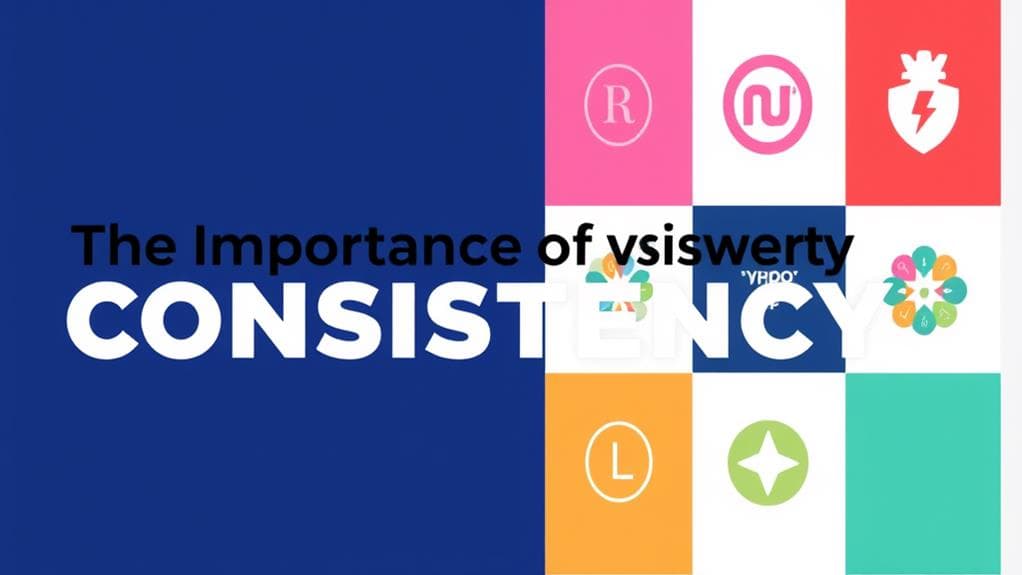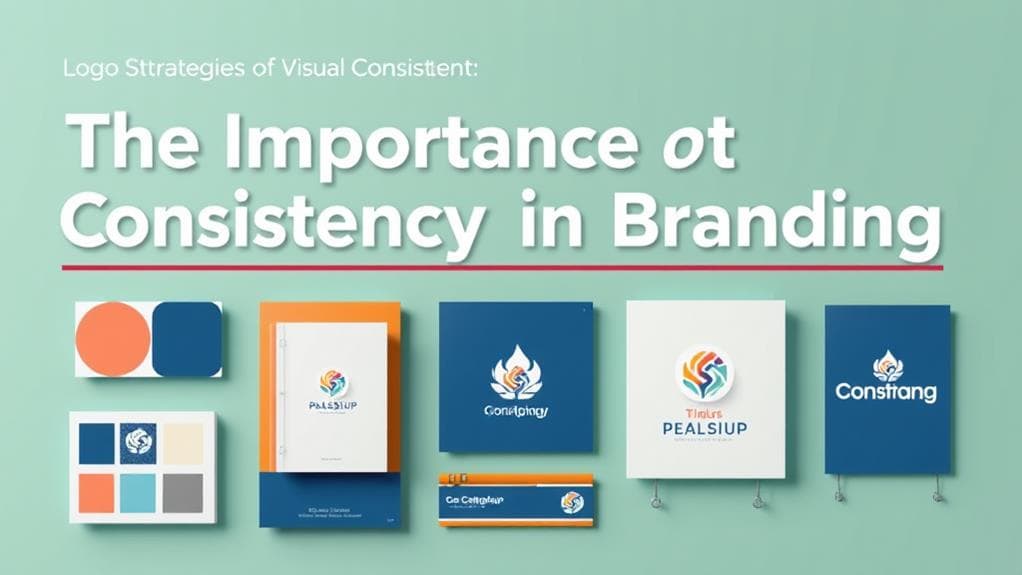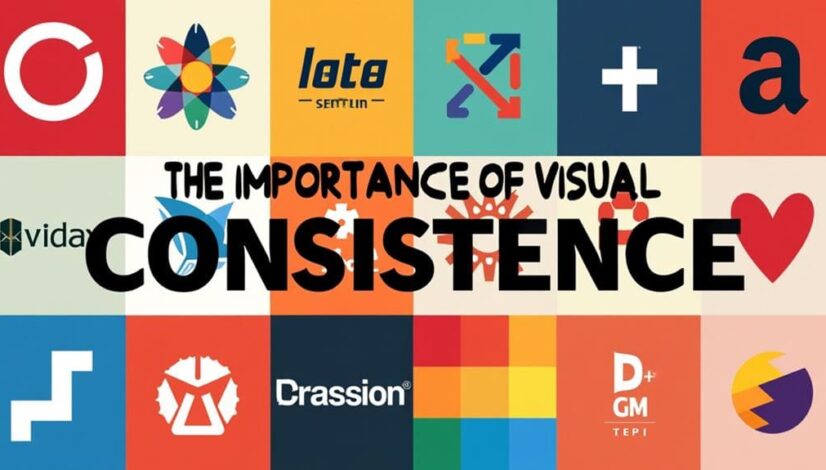The Importance of Visual Consistency in Branding
Visual consistency in branding is essential for cultivating a recognizable identity and building trust with consumers. It enhances brand recognition by up to 80%, establishing emotional connections through effective color psychology and cohesive design elements. A consistent visual strategy reduces confusion, leading to a better user experience and promoting brand loyalty. Additionally, it differentiates a brand from its competitors, fostering long-term equity and consumer advocacy. By implementing thorough brand guidelines and maintaining uniformity across all platforms, companies can create an impactful presence. Explore how the strategic application of these principles can further elevate brand success.
Key Takeaways
- Visual consistency enhances brand identity, leading to immediate recognition and increased brand recall among consumers.
- Cohesive visual strategies create emotional connections, significantly impacting consumer trust and loyalty.
- A well-defined color palette and typography establish a recognizable brand voice that resonates with the target audience.
- Consistent branding reduces confusion, improves user experience, and fosters long-term brand equity development.
- Effective visual elements differentiate brands from competitors, enhancing overall marketing effectiveness and driving sales.
Benefits of Visual Consistency

How can visual consistency enhance a brand's identity and consumer perception? Visual consistency serves as the backbone of effective branding, creating an immediate recognition that transcends superficial elements.
By employing coherent visual strategies—particularly in logo design and the application of color psychology—brands can evoke specific emotional responses, consequently solidifying their identity in the minds of consumers.
Color psychology plays a pivotal role in this process; different colors elicit varied emotional reactions and associations. For instance, blue often conveys trust and reliability, while red can evoke excitement and urgency.
When a brand consistently employs these colors across all platforms, it reinforces its message and cultivates a specific emotional landscape that resonates with its target audience.
Moreover, a well-designed logo acts as a visual anchor for the brand. Consistent logo usage across marketing materials fosters familiarity and builds a sense of community among consumers.
It signals professionalism and attention to detail, which are critical in establishing credibility.
The cumulative effect of visual consistency not only enhances a brand's identity but also influences consumer perception and loyalty.
When consumers encounter a brand that maintains visual coherence, they are more likely to associate it with stability, reliability, and quality.
This trust translates into repeat business and advocacy, as satisfied customers become brand ambassadors.
Hence, the strategic implementation of visual consistency—through thoughtful color choices and cohesive logo design—can notably elevate a brand's marketplace presence and consumer engagement.
Elements of Visual Identity
A robust visual identity comprises several key elements that work synergistically to convey a brand's essence and message. Central to this identity is the color palette, which establishes the emotional tone and psychological impact of a brand. A thoughtfully selected range of colors not only enhances brand recognition but also influences consumer behavior, creating a lasting impression.
Equally important is typography choice, which defines the brand's voice and personality. The right fonts can evoke sophistication, creativity, or trust, and must align with the overall brand narrative.
Complementing these elements, logo design serves as the cornerstone of visual identity, encapsulating the brand's values and mission in a single, memorable symbol.
The imagery style further enriches a brand's visual identity by setting the aesthetic that supports the overall message. Whether through photography, illustration, or graphics, imagery should consistently reflect the brand's ethos and resonate with its target audience.
To maintain coherence across all visual elements, brand guidelines are essential. These detailed documents outline the proper use of the color palette, typography, logo, and imagery, ensuring that all stakeholders adhere to a unified visual strategy.
Building Brand Recognition

While many factors contribute to a brand's success, building brand recognition stands out as an essential objective for any organization seeking to establish a strong market presence. Effective brand recognition hinges on the strategic application of visual elements, with color psychology and logo design serving as foundational pillars.
Color psychology plays a significant role in how consumers perceive a brand. Different colors evoke specific emotions and associations, influencing consumer behavior and brand recall. For instance, blue often conveys trust and reliability, making it a popular choice for financial institutions, while red can evoke excitement and urgency, frequently employed by brands targeting a younger demographic.
By carefully selecting a color palette that aligns with brand values, organizations can create an emotional connection that enhances recognition.
Equally important is the design of the logo. A well-crafted logo serves as the visual cornerstone of a brand, encapsulating its essence in a single image. Simplicity is key; logos that are too complex can be difficult to remember.
Additionally, logos must be versatile, functioning across various mediums without losing impact. A strong logo should also be distinctive, setting the brand apart in a crowded marketplace.
Impact on Consumer Trust
Visual consistency not only aids in building brand recognition but also plays a crucial role in shaping consumer trust. In an increasingly competitive market, where consumers are inundated with choices, establishing visual trust through consistent branding elements is essential. When brands maintain uniformity in their visual identity—be it logos, color palettes, typography, or imagery—they create a cohesive narrative that resonates with consumers. This consistency fosters a sense of reliability; consumers are more likely to perceive a brand as credible, which directly influences their purchasing decisions.
The relationship between visual consistency and brand perception is intricately linked. Brands that exhibit visual inconsistency can confuse and alienate consumers, leading to skepticism and diminished trust. A disjointed visual experience may signal a lack of professionalism or attention to detail, prompting consumers to question the quality of the products or services offered.
Conversely, when a brand presents a polished and consistent image, it signals stability and commitment, reinforcing positive associations in the minds of consumers.
Furthermore, the power of visual trust cannot be underestimated. Research indicates that consumers are more inclined to engage with brands they visually recognize and trust, often leading to increased loyalty and repeat business. In this situation, achieving visual consistency is not merely a branding strategy; it is a foundational element that underpins consumer relationships.
As brands navigate the complexities of consumer behavior, prioritizing visual consistency is crucial for cultivating enduring trust and fostering a loyal customer base.
Strategies for Implementation

Implementing effective strategies for maintaining visual consistency requires a thoughtful approach that encompasses every aspect of a brand's identity. A cohesive color palette serves as the foundation for visual consistency, ensuring that every touchpoint resonates with the brand's ethos and values. By carefully selecting and defining a limited range of colors, brands can evoke specific emotions and create a recognizable presence.
Moreover, establishing extensive typography guidelines is vital. These guidelines should dictate font styles, sizes, and weights that align with the brand's personality, ensuring that all written content—whether digital or print—maintains uniformity and professionalism.
In addition, developing versatile logo variations allows for flexibility across diverse applications without sacrificing brand integrity. Each variation should adhere to the core principles of design, maintaining recognizability in various contexts.
Equally important is the definition of an imagery style that reflects the brand's narrative. This includes considerations for photography, illustrations, and graphics that are consistently applied across all platforms.
To streamline the application of these elements, creating design templates is essential. These templates can be utilized for brand collateral such as business cards, brochures, and social media posts, ensuring that every piece of communication adheres to the established visual standards.
Ultimately, the strategic integration of these components—color palette, typography guidelines, logo variations, imagery style, and design templates—will forge a robust framework for visual consistency, enhancing brand recognition and fostering trust among consumers.
Frequently Asked Questions
How Does Visual Consistency Affect Social Media Marketing Strategies?
Visual consistency in social media marketing strategies greatly enhances brand recognition and audience engagement.
A cohesive color palette and uniform design elements create a recognizable visual hierarchy, allowing brands to stand out in a saturated market.
This consistency not only fosters trust but also amplifies marketing effectiveness, as consumers are more likely to connect with familiar visuals.
Ultimately, a well-defined visual strategy can lead to stronger brand loyalty and improved campaign performance.
Can Visual Inconsistency Damage a Brand's Reputation?
Visual inconsistency can greatly damage a brand's reputation by undermining brand perception and diluting its visual identity.
When elements such as logos, colors, and typography vary across platforms, it creates confusion among consumers, leading to mistrust.
A cohesive visual identity is essential for fostering recognition and loyalty; any deviation can signal unprofessionalism or lack of attention to detail.
Therefore, brands must prioritize visual consistency to maintain their integrity and strengthen their market position.
What Are Common Mistakes in Visual Branding?
In the field of visual branding, common pitfalls can undermine a brand's effectiveness, akin to a modern-day quill pen competing with digital tools.
Missteps often include inconsistent color palettes, excessive logo variations, and haphazard typography choices.
Additionally, neglecting a cohesive imagery style and failing to adhere to established brand guidelines can disrupt visual hierarchy, ultimately confusing the audience.
Mastering these elements is essential for creating a compelling and recognizable brand identity.
How Does Visual Consistency Influence Employee Perception of the Brand?
Visual consistency profoundly influences employee perception of the brand by fostering a sense of belonging and alignment with corporate values.
When employees encounter cohesive branding, it enhances their engagement and reinforces brand loyalty.
This alignment not only nurtures a positive workplace culture but also encourages employees to act as brand ambassadors.
Consequently, a visually consistent brand creates a unified identity that empowers employees, ultimately leading to increased motivation and productivity within the organization.
Are There Industries That Benefit More From Visual Consistency?
Studies indicate that consistent branding can increase revenue by up to 23%.
Industries such as fashion and automotive design benefit greatly from visual consistency, fostering brand loyalty through aesthetic appeal.
In the tech sector and healthcare marketing, cohesive visuals enhance user experience and trust.
Food branding and hospitality aesthetics rely on visual uniformity to evoke desired emotions, while education branding and retail experience utilize it for compelling narratives, ultimately driving consumer engagement and satisfaction.
Conclusion
In the vast ocean of branding, visual consistency serves as the guiding star, illuminating a path toward recognition and trust. A harmonious blend of colors, typography, and imagery weaves a tapestry that captivates the consumer's gaze, forging an unbreakable bond. The strategic implementation of visual identity not only enhances brand recall but also nurtures loyalty, cultivating an emotional connection. Ultimately, brands that embrace visual consistency create a lasting imprint on the hearts and minds of their audience, ensuring their message resonates through time.




